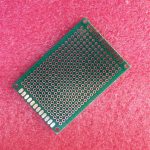Introduction to PCB AXI
Automated X-Ray Inspection (AXI) is a crucial technology in the PCB assembly process that ensures the quality and reliability of printed circuit boards. AXI systems use advanced imaging techniques to detect defects and anomalies in PCBs that are not visible to the human eye. This non-destructive testing method has become increasingly popular among PCB assembly companies due to its ability to identify potential issues early in the manufacturing process, reducing the risk of costly failures and product recalls.
Benefits of PCB AXI
- Improved quality control
- Increased efficiency
- Cost savings
- Enhanced reliability
- Compliance with industry standards
How PCB AXI Works
AXI systems utilize high-powered X-rays to penetrate the surface of a PCB and create detailed images of its internal structure. These images are then analyzed by sophisticated software algorithms that compare the actual PCB design to the intended design, identifying any discrepancies or defects.
Key Components of an AXI System
- X-ray source
- X-ray detector
- Imaging software
- Conveyor system
- User interface
Common Defects Detected by PCB AXI
| Defect Type | Description |
|---|---|
| Solder joint defects | Insufficient solder, bridging, voids, or poor wetting |
| Component placement issues | Misaligned, missing, or incorrect components |
| PCB laminate defects | Delamination, cracks, or voids in the PCB substrate |
| Trace and pad defects | Broken traces, insufficient copper thickness, or pad damage |
Top PCB Assembly Companies with AXI Capabilities
1. Jabil
Jabil is a global manufacturing services company that offers a wide range of PCB assembly services, including AXI. With state-of-the-art facilities and a commitment to quality, Jabil has established itself as a leader in the industry.
Jabil’s AXI Capabilities
- 2D and 3D AXI systems
- Inline and offline inspection options
- Customized inspection algorithms
- Integration with other quality control processes
2. Foxconn
Foxconn is a Taiwanese electronics manufacturing company that provides PCB assembly services to a diverse range of industries. The company has invested heavily in AXI Technology to ensure the highest levels of quality and reliability.
Foxconn’s AXI Capabilities
- High-speed inline AXI systems
- Advanced defect detection algorithms
- Automated data analysis and reporting
- Continuous process improvement based on AXI data
3. Celestica
Celestica is a Canadian multinational electronics manufacturing services company that specializes in PCB assembly and other value-added services. The company has implemented AXI technology across its global network of facilities to deliver consistent quality to its customers.
Celestica’s AXI Capabilities
- Multi-vendor AXI systems
- Customizable inspection parameters
- Real-time data collection and analysis
- Seamless integration with manufacturing execution systems (MES)

Implementing PCB AXI in the Assembly Process
Integrating AXI into the PCB assembly process requires careful planning and execution. Companies must consider factors such as inspection coverage, cycle time, and data management to ensure optimal results.
Best Practices for Implementing PCB AXI
- Define inspection requirements and acceptance criteria
- Select appropriate AXI systems and software
- Develop inspection programs and algorithms
- Establish data collection and analysis procedures
- Train operators and maintenance personnel
- Continuously monitor and optimize AXI performance
Challenges and Solutions in PCB AXI Implementation
| Challenge | Solution |
|---|---|
| False calls and escapes | Fine-tune inspection algorithms and parameters |
| Inspection coverage limitations | Use complementary inspection methods (e.g., AOI, ICT) |
| Data management and analysis | Implement robust data management systems and analytics tools |
| Integration with other processes | Develop seamless interfaces and standardized data formats |
Future Trends in PCB AXI Technology
As the demand for high-quality and reliable PCBs continues to grow, AXI technology is expected to evolve and improve in the coming years. Some of the key trends and developments to watch include:
1. Artificial Intelligence and Machine Learning
AI and ML algorithms will play an increasingly important role in AXI systems, enabling more accurate and efficient defect detection and classification. These technologies will help reduce false calls and escapes while improving overall inspection performance.
2. Inline Computed Tomography (CT)
Inline CT is an emerging technology that combines the benefits of AXI and computed tomography to provide even more detailed and accurate 3D images of PCBs. This technology will enable the detection of defects that are currently difficult or impossible to identify with traditional AXI systems.
3. Integration with Industry 4.0
As the manufacturing industry moves towards Industry 4.0, AXI systems will become more closely integrated with other smart factory technologies, such as IoT sensors, big data analytics, and cloud computing. This integration will enable real-time monitoring, predictive maintenance, and continuous process improvement.
Conclusion
PCB AXI is a critical technology for ensuring the quality and reliability of printed circuit boards in today’s fast-paced and demanding electronics industry. By partnering with PCB assembly companies that have invested in state-of-the-art AXI capabilities, businesses can reduce the risk of costly failures and product recalls while improving overall product performance and customer satisfaction.
As AXI technology continues to evolve and mature, it will play an even more crucial role in the future of PCB assembly. Companies that embrace these advancements and integrate them into their manufacturing processes will be well-positioned to succeed in an increasingly competitive market.
Frequently Asked Questions (FAQ)
-
Q: What is the difference between 2D and 3D AXI?
A: 2D AXI provides a top-down view of the PCB, while 3D AXI uses multiple X-ray angles to create a three-dimensional image of the board. 3D AXI offers more detailed and accurate inspection capabilities, particularly for complex PCB designs. -
Q: Can AXI detect all types of PCB defects?
A: While AXI is a powerful inspection tool, it may not detect all types of defects. Some defects, such as surface contamination or electrical shorts, may require additional inspection methods like automated optical inspection (AOI) or in-circuit testing (ICT). -
Q: How does AXI compare to manual X-ray inspection?
A: AXI offers several advantages over manual X-ray inspection, including higher throughput, better consistency, and the ability to detect smaller defects. However, manual X-ray inspection may still be necessary for certain applications or to verify AXI results. -
Q: What factors should be considered when selecting an AXI system?
A: When choosing an AXI system, consider factors such as inspection speed, resolution, defect detection capabilities, ease of use, and compatibility with your existing manufacturing processes. It’s also important to evaluate the supplier’s support and training services. -
Q: How can I ensure the effectiveness of my AXI process?
A: To ensure the effectiveness of your AXI process, establish clear inspection requirements and acceptance criteria, develop robust inspection programs and algorithms, and continuously monitor and optimize AXI performance. Regular maintenance and calibration of AXI equipment are also critical for maintaining inspection accuracy and consistency.






Leave a Reply